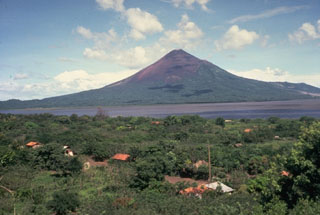Report on Momotombo (Nicaragua) — 30 December-5 January 2016
Smithsonian Institution / US Geological Survey
Weekly Volcanic Activity Report, 30 December-5 January 2016
Managing Editor: Sally Sennert.
Please cite this report as:
Global Volcanism Program, 2015. Report on Momotombo (Nicaragua) (Sennert, S, ed.). Weekly Volcanic Activity Report, 30 December-5 January 2016. Smithsonian Institution and US Geological Survey.
Momotombo
Nicaragua
12.423°N, 86.539°W; summit elev. 1270 m
All times are local (unless otherwise noted)
INETER reported that during 29-30 December no explosions at Momotombo were detected, though Real-time Seismic-Amplitude Measurements (RSAM) continued to be at moderate-to-high levels. Based on INETER and SINAPRED reports, three gas-and-ash explosions on 2 January, at 1333, 1426, and 1434, excavated the remaining parts of the lava dome which was emplaced about a month ago. An ash plume rose 500 m above the crater, drifted S and SW, and caused ashfall in Puerto Momotombo (9 km WSW). Possible ash plumes from an explosion at 2129 were hidden by darkness. At 0420 on 3 January an explosion ejected lava bombs 2 km away and caused ashfall in La Paz Centro (18 km SW). Lava flows had advanced as far as 2 km down the NE flank.
Geological Summary. Momotombo is a young stratovolcano that rises prominently above the NW shore of Lake Managua, forming one of Nicaragua's most familiar landmarks. Momotombo began growing about 4500 years ago at the SE end of the Marrabios Range and consists of a somma from an older edifice that is surmounted by a symmetrical younger cone with a 150 x 250 m wide summit crater. Young lava flows extend down the NW flank into the 4-km-wide Monte Galán caldera. The youthful cone of Momotombito forms an island offshore in Lake Managua. Momotombo has a long record of Strombolian eruptions, punctuated by occasional stronger explosive activity. The latest eruption, in 1905, produced a lava flow that traveled from the summit to the lower NE base. A small black plume was seen above the crater after a 10 April 1996 earthquake, but later observations noted no significant changes in the crater. A major geothermal field is located on the south flank.
Sources: Sistema Nacional para la Prevención, Mitigación y Atención de Desastres (SINAPRED), Instituto Nicaragüense de Estudios Territoriales (INETER)

